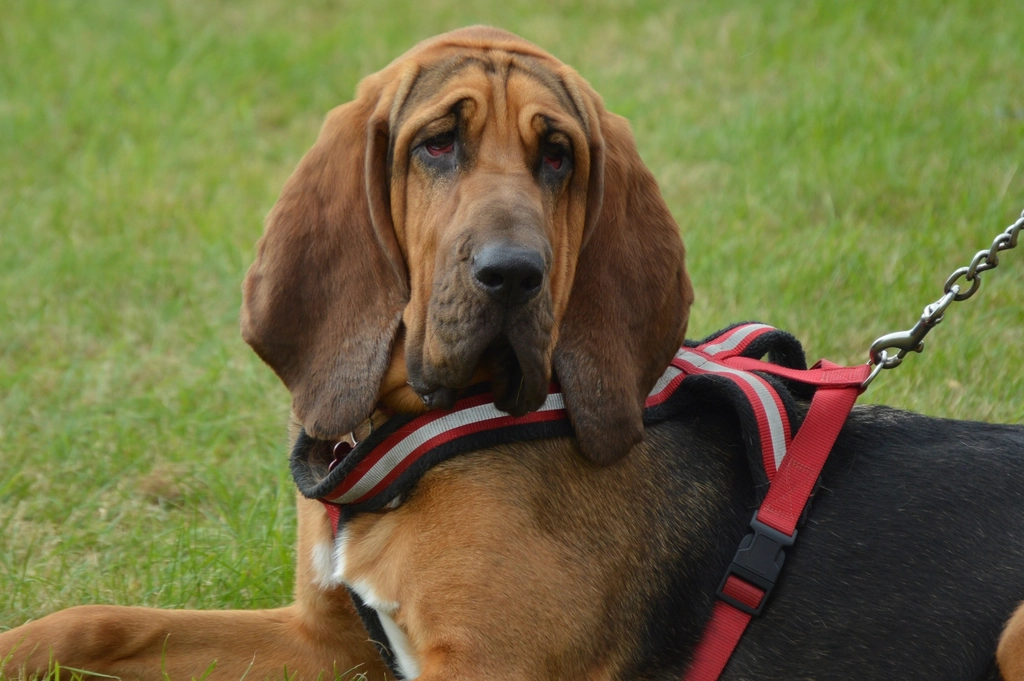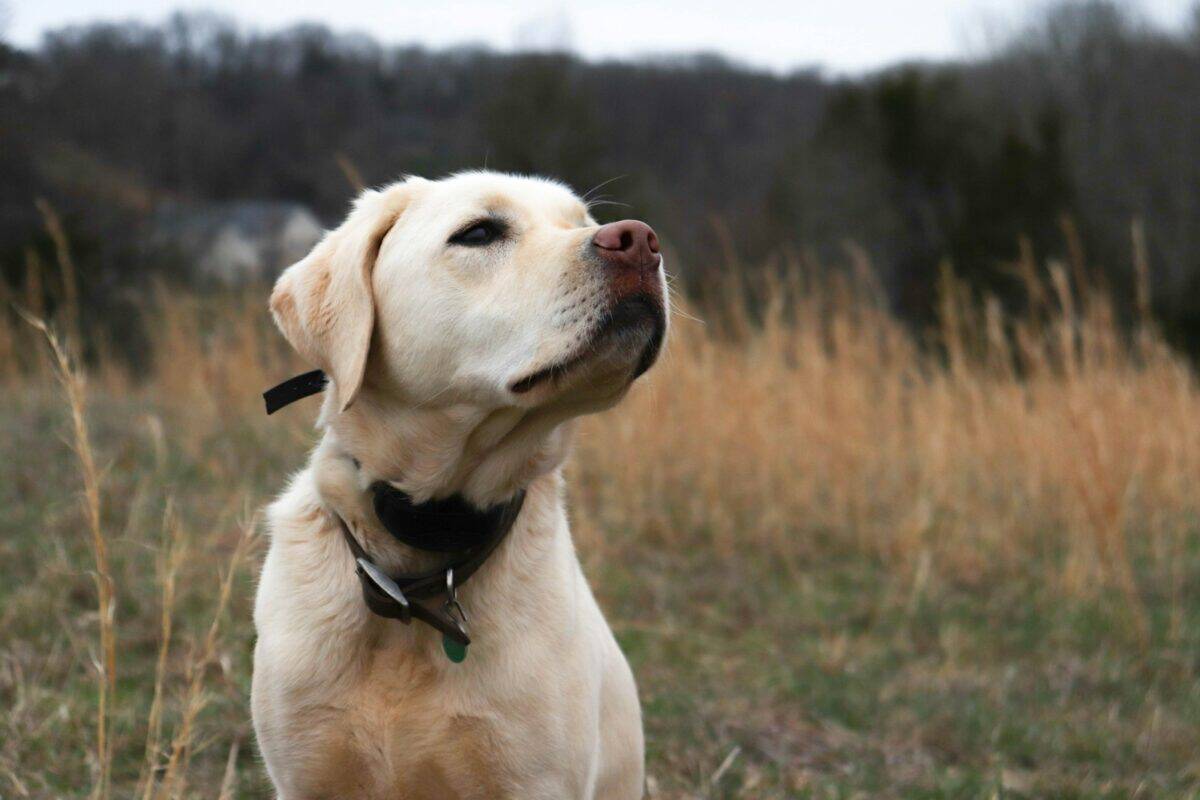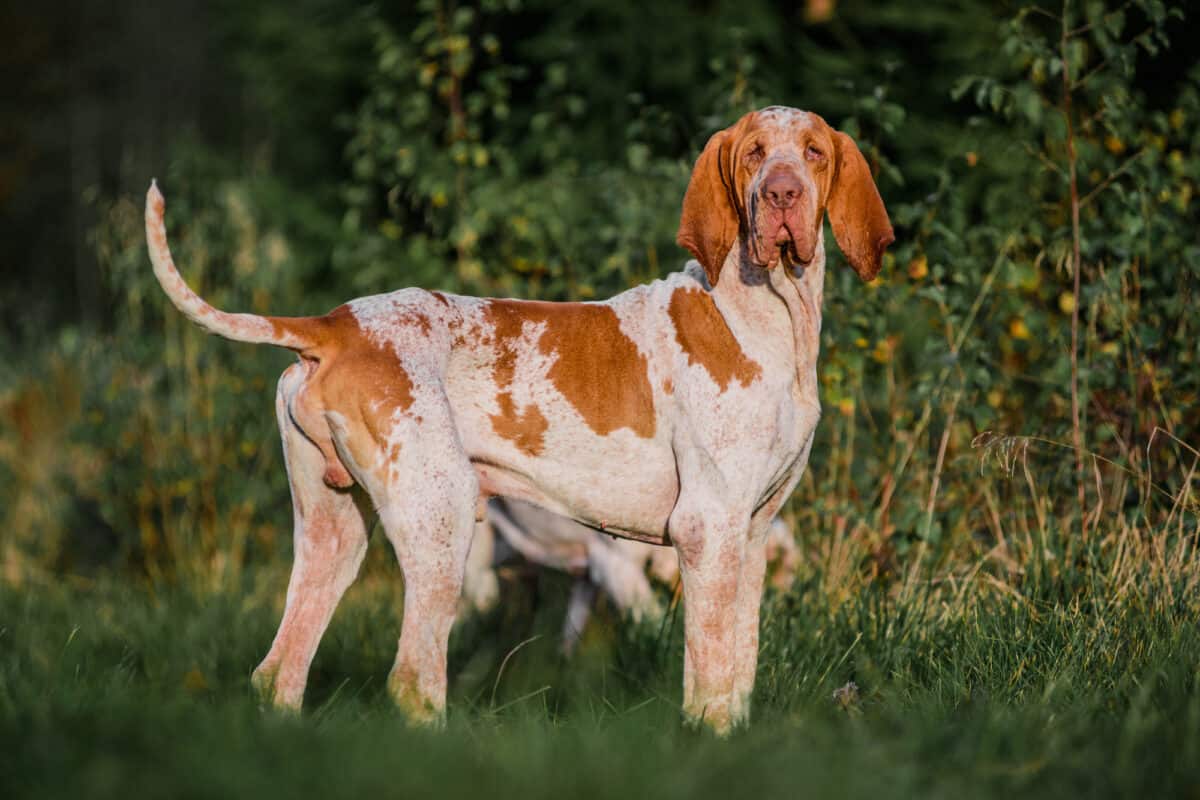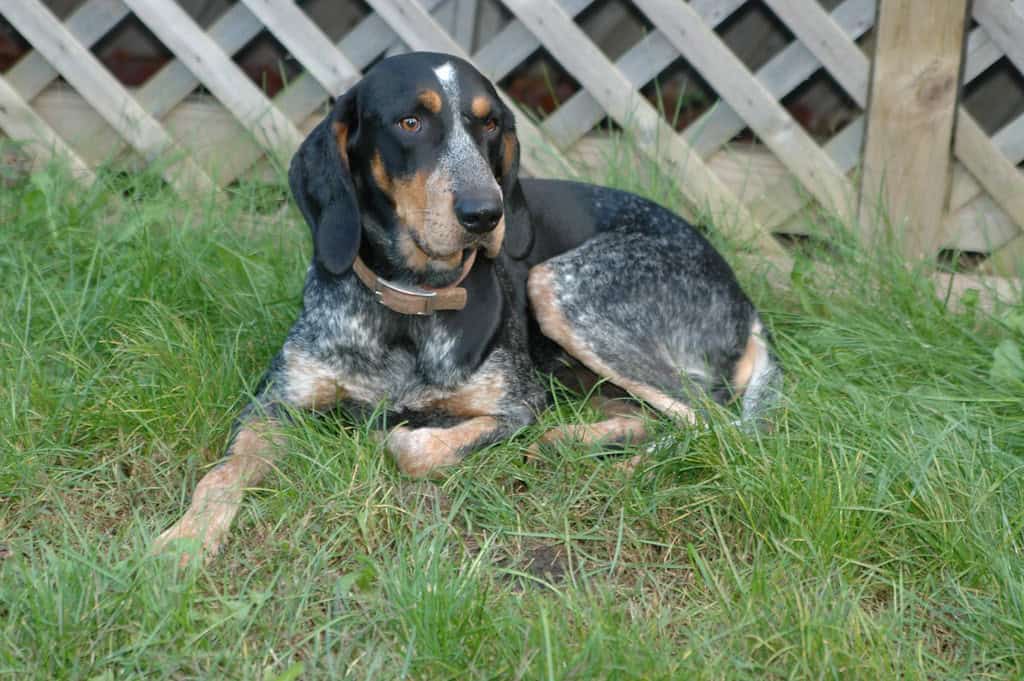The canine nose is a remarkable biological instrument, capable of detecting scents at concentrations nearly 100,000 times lower than what humans can perceive. While all dogs possess an impressive olfactory system, certain breeds stand out for their extraordinary ability to detect, differentiate, and track scents. These exceptional sniffers have been selectively bred over generations to enhance their natural smelling abilities, making them invaluable partners in search and rescue operations, law enforcement, medical detection, and hunting. Their superior sense of smell comes from having up to 300 million olfactory receptors compared to our mere 6 million, plus a dedicated portion of their brain that analyzes scents is proportionally 40 times larger than ours. Let’s explore the 12 dog breeds renowned worldwide for their remarkable olfactory capabilities and the unique characteristics that make each breed’s nose particularly special.
12. Bloodhound

Often called “a nose with a dog attached,” the Bloodhound reigns supreme in the canine olfactory world. With approximately 300 million scent receptors—the most of any dog breed—Bloodhounds can follow trails that are over 300 hours old and across extremely challenging terrains. Their long, drooping ears and wrinkled skin around the face and neck serve a functional purpose, helping to trap and concentrate scent particles toward their nostrils. Bloodhounds’ scent evidence is so reliable that it’s admissible in courts of law in many jurisdictions. These gentle giants can follow a specific human scent through complex environments where the target person may have crossed paths with hundreds of others, distinguishing that individual’s unique odor signature from the countless competing smells.
11. Basset Hound

Like their Bloodhound cousins, Basset Hounds possess an extraordinary sense of smell, ranking second only to Bloodhounds among scenting breeds. Their long, droopy ears help sweep scent particles toward their nose, while their short stature keeps them close to the ground where scents linger. Originally bred in France for hunting small game, particularly rabbits, Bassets can track scents over long distances without tiring. Their heavy bone structure and short legs were purposefully developed to allow hunters on foot to keep pace with them. With approximately 220 million scent receptors, Basset Hounds can distinguish individual components within complex scent mixtures, making them excellent detection dogs when speed isn’t the primary requirement. Their methodical, persistent tracking style is ideal for following complex scent trails.
10. German Shepherd

The German Shepherd combines an exceptional sense of smell with high intelligence and trainability, making them one of the most versatile working dogs. With approximately 225 million scent receptors, these dogs excel in police work, search and rescue, and military applications. Their ability to work in diverse environments—from disaster zones to airports—while maintaining focus on specific scent targets makes them invaluable service dogs. German Shepherds can be trained to detect narcotics, explosives, accelerants in arson investigations, currency, and even specific medical conditions. Their athletic build allows them to cover large search areas efficiently, while their problem-solving intelligence helps them navigate complex environments while tracking. This combination of olfactory prowess and working intelligence has made German Shepherds the breed of choice for police and military units worldwide.
9. Beagle

Don’t let their compact size fool you—Beagles pack about 225 million scent receptors into their small noses, giving them one of the most powerful scenting abilities in the canine world. Their scenting prowess, combined with their small size, friendly demeanor, and non-threatening appearance, makes them ideal for detection work in sensitive environments like airports and border crossings. The Department of Homeland Security employs Beagles in their “Beagle Brigade” to detect prohibited agricultural products and foods at points of entry. Originally bred as scent hounds for hunting rabbits and hares, Beagles are single-minded when following a scent trail, which can sometimes appear as stubbornness but is actually intense focus and determination. Their exceptional noses are also being utilized in medical detection, where they can identify certain cancers and detect dangerous blood sugar levels in diabetic patients.
8. Belgian Malinois

The Belgian Malinois combines an excellent nose with exceptional work ethic, intelligence, and athletic ability, making them increasingly popular for scent-detection work. With approximately 225 million scent receptors, these dogs excel in environments where both scenting ability and physical agility are required. They’ve become the preferred choice for many military and police units worldwide because they can track scents while navigating challenging terrain and remaining alert to potential threats. Belgian Malinois can be trained to detect explosives, narcotics, human remains, and even electronic devices like cell phones and USB drives in correctional facilities. Their high energy and intense drive need proper channeling, but when professionally trained, they can work in extreme conditions while maintaining focus on their scent targets. The breed’s lower maintenance coat compared to German Shepherds makes them particularly suitable for hot-climate operations.
7. Labrador Retriever

Labrador Retrievers combine approximately 220 million scent receptors with an eager-to-please temperament that makes them exceptional detection dogs across various fields. Originally bred to retrieve waterfowl, their scenting abilities have been adapted to detect everything from drugs and explosives to cancer and low blood sugar in diabetics. Labs excel as search and rescue dogs, particularly in disaster situations where they can detect human scent under building rubble or in areas affected by avalanches. Their friendly appearance makes them ideal for working in public settings, and their adaptability allows them to work in diverse environments from airports to hospitals. Their natural love of food rewards makes training relatively straightforward, while their excellent scent discrimination allows them to identify specific target odors even in environments filled with competing smells. Labradors’ versatility and reliability have made them the most popular assistance and detection dog worldwide.
6. Coonhound

The various Coonhound breeds—including Black and Tan, Bluetick, Redbone, and Treeing Walker—were developed in America specifically for tracking raccoons and other game through challenging wilderness terrain. With approximately 230 million scent receptors, Coonhounds can follow cold trails through water, dense underbrush, and over diverse landscapes. What distinguishes these hounds is their “cold nose” ability—they can follow scent trails that are several days old, a skill that makes them valuable for search and rescue operations in wilderness settings. Their distinctive baying vocalization serves a practical purpose, allowing hunters to follow the sound when the dogs track through dense vegetation. Coonhounds possess remarkable scent discrimination, enabling them to follow a specific animal’s trail even when it crosses paths with numerous other animals. Their endurance allows them to track for hours without tiring, making them excellent for long-duration search operations.
5. English Springer Spaniel

English Springer Spaniels combine approximately 220 million scent receptors with exceptional energy and enthusiasm, making them outstanding detection dogs, particularly for law enforcement. Developed to flush or “spring” game for hunters, these dogs have been repurposed for detecting contraband, explosives, and human remains. Their moderate size allows them to search confined spaces, vehicles, and luggage efficiently, while their friendly appearance makes them less intimidating in public settings. The breed has become particularly prominent in countries like the UK for customs and border security work. Springer Spaniels possess remarkable scent discrimination abilities, enabling them to identify specific odors among complex mixtures. Their natural hunting instincts translate perfectly to search work, as they’re inherently motivated to locate hidden objects through scent. Additionally, their high energy and stamina allow them to work for extended periods, making them cost-effective working dogs for agencies with high-volume screening requirements.
4. Dachshund

The Dachshund’s scenting abilities often surprise people who view them merely as companion dogs. Originally bred to hunt badgers and other burrowing animals, these “little sausage dogs” possess approximately 125 million scent receptors—fewer than some specialized scent hounds but still remarkably powerful. Their long, low build was purposefully developed to allow them to follow scent trails into narrow tunnels and dens. Dachshunds were specifically bred to track by scent, and their stubborn determination (sometimes perceived as stubbornness) reflects their single-minded focus when following a scent trail. The breed comes in three coat varieties—smooth, wire-haired, and long-haired—each originally developed for different hunting conditions and terrains. While rarely used in official detection work today, Dachshunds’ natural scenting abilities make them exceptionally alert to environmental changes, and some are trained for truffle hunting. Their keen nose and tenacious personality make them surprisingly effective at scent-based activities despite their diminutive size.
3. Pointer

The Pointer’s exceptional sense of smell works seamlessly with their unique hunting style, where they detect game birds from remarkable distances and then “point” to indicate the location. With approximately 220 million scent receptors, these athletic dogs can detect bird scent from over 100 yards away under ideal conditions. Unlike hounds that follow ground scent, Pointers specialize in detecting airborne scent particles, a different application of olfactory power. Their keen ability to detect minute scent molecules in the air makes them valuable for certain types of detection work beyond hunting. Pointers are increasingly being utilized in conservation efforts to detect specific invasive species or endangered wildlife through scent detection. Their natural air-scenting abilities translate well to detecting volatile organic compounds, including certain types of mold, fungi, and even some medical conditions. Their intense focus and high energy require proper channeling, but when trained correctly, their scenting precision is extraordinary.
2. Bluetick Coonhound

The Bluetick Coonhound deserves specific mention among coonhound varieties for its exceptional cold-trailing abilities. With approximately 230 million scent receptors, these distinctively marked hounds can follow scent trails that are several days old through challenging wilderness terrain. Originally developed in Louisiana from French staghounds, these dogs were specifically bred to track in hot, humid conditions where scent dissipates quickly. Their “cold nose” ability allows them to detect and follow faint scent particles that have settled into the ground even after significant time has passed. Blueticks are particularly adept at maintaining focus on a specific scent trail even when crossing multiple other animal trails. Their distinctive bawling howl served a practical purpose before the era of GPS tracking, allowing hunters to follow their progress through dense forests. Today, their exceptional scenting abilities make them valuable for search and rescue operations in wilderness settings and for tracking lost persons in rural environments.
1. Redbone Coonhound

The striking solid-red Redbone Coonhound possesses approximately 230 million scent receptors, giving them extraordinary tracking abilities, particularly in challenging environments. Developed in the American South specifically for tracking in swampy terrain, these dogs can follow scent through water, mud, and dense vegetation where scent particles disperse quickly. Their waterproof coat and strong swimming abilities allow them to track across streams and swampy areas without losing scent—a remarkable feat considering how water typically disrupts scent trails. Redbones are known for their “hot nose” trailing, meaning they excel at following fresh scent trails with intensity and focus. Their tracking style combines speed with accuracy, making them efficient in time-sensitive search operations. Originally bred to tree raccoons and cougars, their versatile scenting abilities have made them valuable for search and rescue operations, particularly in wilderness and disaster settings. Their friendly, trainable nature, coupled with their powerful nose makes them adaptable to various scent detection roles beyond traditional hunting.
Conclusion:

The extraordinary olfactory capabilities of these 12 dog breeds represent one of nature’s most remarkable sensory adaptations, developed and refined through centuries of selective breeding. While humans have leveraged these dogs’ incredible noses for hunting, law enforcement, and search and rescue, we’re still discovering new applications for canine scent detection in fields ranging from medicine to conservation. Understanding the specific scenting strengths of different breeds helps match the right dog to the right detection task, whether that requires the methodical approach of a Bloodhound, the versatility of a Labrador, or the precision of a Pointer. As science continues to unravel the mysteries of how dogs perceive their world through scent, we gain not only a deeper appreciation for their abilities but also new opportunities to work alongside these remarkable animals in solving human challenges. The canine sense of smell remains one of the most sophisticated biological detection systems on the planet—a reminder that despite our technological advances, we still have much to learn from our four-legged companions.
- 10 U.S. States Where You Are Likely to Spot a Wild Fox - August 18, 2025
- Salmon Swim Upstream for Miles to Lay Their Eggs But What Guides Them Home - August 18, 2025
- 9 Snakes That Love the Desert And 6 That Need Moisture - August 18, 2025

